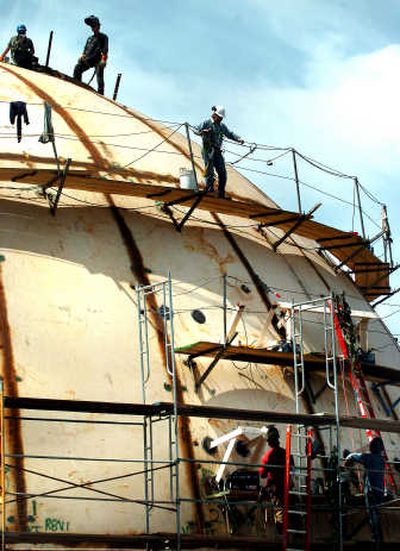New sewage plant tanks more efficient, safer

The death of a sewage plant maintenance worker in 2004 set the stage for a multimillion dollar project to build two egg-shaped sewage “digesters” at Spokane’s wastewater treatment plant on Aubrey L. White Parkway.
Crews are midway into the $45 million project to erect twin steel tanks, each capable of holding 2.85 million gallons of sewage sludge.
When completed about a year from now, the tanks will provide Spokane’s sewage plant with a more efficient system for turning sewage solids into fertilizer. The digesters use anaerobic bacteria to reduce and convert the solids.
The new digesters also will help the city attain strict limits on the release of phosphorus into the Spokane River, part of federal and state mandates to clean up the waterway.
“By this time next year, I expect we will be operating these,” said Lars Hendron, city wastewater engineer for the project.
The two new tanks will replace a 2.2-million-gallon concrete digester that failed in 2004 when too much sewage was pumped into the tank. Worker Mike Cmos Jr. had gone onto the lid of the tank to contain spilling sludge when the lid separated from the tank walls and collapsed into the sludge, killing him.
The steel tanks are expected to be less vulnerable to failure than the three original pancake-shaped concrete tanks. Also, their egg-shaped design will allow for better mixing of the sludge as it is being treated. They also require less maintenance, which means the tanks will be opened fewer times, reducing odors escaping into the area.
Garco Construction Inc. of Spokane is the general contractor, while Chicago Bridge and Iron, based in Chicago, is the subcontractor erecting the tanks.
The job site was the scene of tragedy last December when a 26-year-old North Idaho resident and Garco employee, Tizoc Gayton, was killed while removing sheet piling in a temporary retaining wall.
The new tanks are part of a $500 million upgrade of the city’s wastewater system by 2018.
Improved filtration of wastewater effluent will create even more solids for the digesters to process. Improved filtration to reduce phosphorus pollution of the river is expected to be installed by 2014.
The city is collecting a $13-a-month surcharge on sewer bills to pay for improvements over a period of years rather than selling bonds and incurring interest charges.
The biggest difference between the old and new tanks is their height. While the pancake-shaped digesters stand about 35 feet above ground, the egg-shaped digesters will rise 65 feet, including their two concrete access towers and walkways.
The new digesters would have been even taller, but designers figured out a way to dig into the ground to reduce their overall height.
“We knew they were going to be big. We wanted to make sure we set them into the ground as deep as we could,” said Dale Arnold, city wastewater director.
They are 88 feet in diameter compared with the pancake digesters’ diameter of 100 feet.
The new digesters also include internal pumping systems to reduce noise.
The tanks will be painted green to help them blend into the environment.
And a containment berm is being built around the tanks to contain any potential spills.
In addition to the digesters, the sewage treatment plant has a new building to house five boilers for making use of methane gas given off by the sewage. The steam energy is being routed throughout the plant and will be used to keep the sludge warmed as it is being “digested.”
Eventually, the city may be able to generate electricity from the steam, but that is not financially feasible now, officials said.
Wastewater officials have not decided what to do with the two remaining concrete digesters. They could be retrofitted or used for storage of excess sludge. Or they could be removed to make room for a third egg-shaped digester someday, officials said.